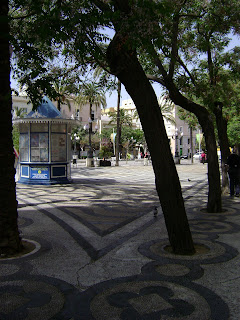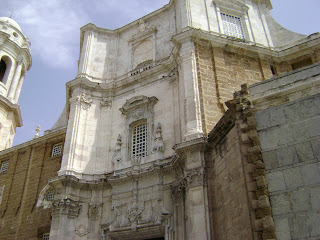





With my laptop out of commission as far as any wireless connection was concerned, I had not been able to enjoy my photographs of the Mediterranean for a long time, nor to be able to update this site as I would have liked.
It was tonight that I finally looked at some of my Mediterranean photographs again. Like a vagabond of the ethernet, I have been taking my external drive from computer to computer, never able to call any computer home...
In any event, I rediscovered Cadiz tonight. Some of the smaller ports of the Mediterranean, like Cadiz and Valletta were exquisite jewels. I miss the ocean terribly now that I live inland, and being able to walk along the beachfronts with the wind in my face, beneath the shadow of walls and buildings hundreds of years old, was an unforgettable experience. I long to return.
Cadiz is one of the oldest cities in Iberia, and in fact is believed to be the oldest city in Western Europe that remains standing. Its official foundation date is 1104 B.C. Its original name was Gadir. As an outpost established by the Phoenicians, Gadir was a thriving port.
The Greeks believed that Hercules himself founded Gadir after he completed his 10th labour, the slaying of Geryon, a giant with three heads, three torsos and a single pair of legs. As late as the third century, a tumulus in Gadir was associated with the burial of Geryon.
One of the most famous temples in Gadir in antiquity was dedicated to the Phoenician god Melqart and some believe the columns of this temple to have been the original source of the legend of the Pillars of Hercules.
In 500 B.C., Hannibal used Gadir as a base of operations in his conquest of Iberia. Actually, 'conquest' may be misleading in this context as the Punic wars consisted of a conflict between two nations, Carthage and Rome. Cities in Iberia basically allied themselves first with one and then the other during this period.
The sands of Cadiz were threaded with tiny perfect shells. As I waded in the shallow waters close to the shore, collecting souvenirs, I thought of the ancient warriors from Carthage and Rome who conquered and reconquered this city. The contemporary atmosphere of lazy peace that pervades this quiet civilised port is undisturbed by echoes of far those brutal struggles... Yet reminders of conflict can be found in the architecture of every port in the Mediterranean. The silhouettes of magnificent forts and city walls may not resonate now with the cries of the doomed, but their purpose primarily was defence from a world that sought to control their native populations.
Thousands of years later, one can explore the history of those conflicts while retaining emotional distance from the true reality of war. Ancient war was no more romantic than contemporary warfare, and yet anything that remote from us in time achieves an undeniable mystique, transforming conflicts based in greed and exploitation to mythical heroics.
One of the most delightful encounters in Cadiz was an unexpected sight of the cats who lived at the beach. Unlike the feral cats of mainland Italia, who tend to be half-starved, these cats appeared almost pampered. Residents obviously provided them regularly with food and water. Little dishes and bowls were stashed discreetly in niches along the rocky shoreline.
The Cathedral was too large to be called 'exquisite' but it was magnificent. I wish I could spend a fortnight or so in Cadiz. One day was not sufficient by any means.